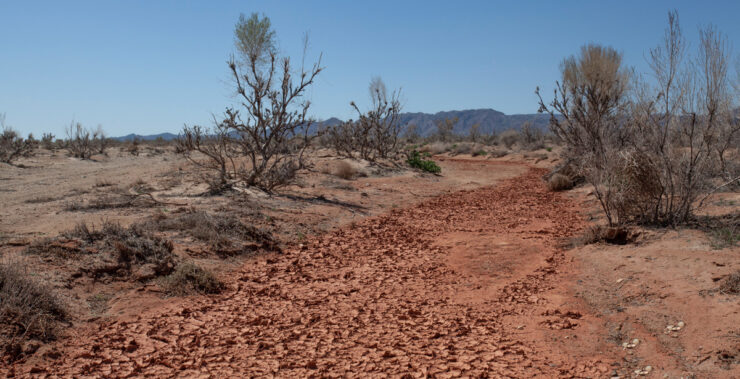Experts from Central Asian countries (except Turkmenistan) discussed the issue of environmental migration and its possible increase in the future at a meeting organized by CABAR.asia.
Projections indicate that global warming could result in 216 million environmental migrants worldwide by 2050. A summary of the meeting highlighting the main points made by the experts has been published on the CABAR.asia website.
The concept of “environmental migrant”
The concept of “environmental migrant” has emerged recently and it is becoming more common in discussions, though it is not always legally defined. According to the International Organization for Migration, “environmental migrants” are defined as people, who are “obliged to leave their habitual homes, or choose to do so, either temporarily or permanently, and who move either within their country or abroad due to adverse effects of the changing environment on their lives”.
In Kazakhstan and Kyrgyzstan, status of an “environmental migrant” is not yet recognized. In Tajikistan, however, the term and status are officially recognized and managed by several ministries, including the Ministry of Labor, Migration, and Employment, the Ministry of Emergency Situations, the Main Department of Geology, among others.
Environmental migration in Central Asia
Although most countries in the region do not keep detailed statistics on environmental migration, experts reported that it has been occurring for some time.
- In Kazakhstan, environmental migration has been ongoing for many years. During the 1990s, some people moved away from the Aral Sea region due to soil and water pollution and the resulting health effects.
- In Kyrgyzstan, annual mudslides and floods cause temporary and internal environmental migration. Surveys have shown a direct link between worsening climate conditions, increased natural disasters, and migration. In areas like Naryn and Jalal-Abad, where livestock farming is common, more people reported moving away compared to other regions. Harsh weather conditions limit the food and feed supply, making farming more challenging.
- In Tajikistan, environmental migration began in the early 2000s. In 2002-2024, 72 thousand families were relocated from hazardous zones. Currently, more than 1200 locations are identified as environmentally threatened due to mudflows, landslides, floods, and earthquakes.
- In Uzbekistan, environmental migration is not tracked and the issue does not yet receive attention. Despite the lack of official statistics, it is known that many people have moved away from the Aral Sea region due to environmental degradation, including loss of soil fertility, high soil salinization, dust storms, and poor air quality. More than 400 thousand ethnic Kazakhs moved to Kazakhstan with the help of “Kazakhstan – the Centre for Support of Environmental Migrants from Uzbekistan”, while many Uzbeks and Karakalpaks relocated to the Tashkent region. People are also relocating away from Fergana Valley, due to lack of water and reduced agriculture.
With the worsening climate crisis and its more frequent and severe consequences such as glacial melting, desertification, and floods, environmental migration in the region is expected to rise. In Kazakhstan, mudflows are projected to increase tenfold, threatening 156 cities and towns, including Almaty. In Uzbekistan, the situation may worsen, as 25% of the economy and workforce are engaged in agriculture, a sector heavily impacted by climate change.
Donate to support Turkmen analysts, researchers and writers to produce factual, constructive and progressive content in their efforts to educate the public of Turkmenistan.
SUPPORT OUR WORKDifficulties faced by migrants and actions by the government
Experts noted that people often struggle to accept the need for relocation, as they may have lived on their lands for years or centuries. The expert from Tajikistan reported occasional difficulties in persuading people to move away because the dangers are not fully understood, requiring extensive explanation and education.
Some countries in the region provide significant assistance to environmental migrants. For example:
- In Tajikistan, in areas in the mountains identified as “dangerous”, the government develops relocation plans. New residential areas are prepared with necessary infrastructure, starting with healthcare facilities, followed by power supply and roads. The government also assists with relocation of environmental migrants and provides interest-free loans, as well as financial help to each family.
- In Uzbekistan, large funds are allocated by the government to the Aral Sea region, including for water supply and building a new airport. Efforts have been made to plant saxaul on the dried areas of the sea to reduce dust storms. These measures aim to prevent the population from permanently leaving the area. Additionally, work is done to prevent and adapt to the consequences of climate change.
- In Kyrgyzstan, the Ministry of Emergency Situations has a protocol for evacuating the population during disasters.
Issues and environmental migration in Turkmenistan
Although no expert from Turkmenistan was present at the meeting and no specific experience on environmental migration could be discussed, the issues raised by other experts are relevant and urgent for Turkmenistan. The country faces extreme weather events, poor air quality due to the Aral Sea disaster, limited water supply, wasteful water use, and significant migration away from the country. These challenges might be the factors making the country uninhabitable, further increasing environmental migration. Given the urgency of the situation, it is crucial for Turkmenistan to enhance its participation in expert talks, conferences, and other events, and to strengthen regional cooperation.






